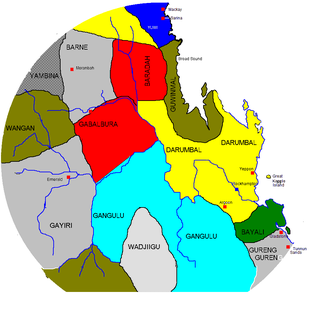Related Research Articles
The Ngaro are an Australian Aboriginal group of people who traditionally inhabited the Whitsunday Islands and coastal regions of Queensland, employing a seafaring lifestyle in an area that archaeologically shows evidence of human habitation since 9000 BP. Ngaro society was destroyed by warfare with traders, colonists, and the Australian Native Police. The Native Police Corps forcibly relocated the remaining Ngaro people in 1870 to a penal colony on Palm Island or to the lumber mills of Brampton Island as forced labourers.

The Gangulu people, also written Kangulu, Kaangooloo, Ghungalu and other variations, are an Aboriginal Australian people from the Mount Morgan area in Queensland, Australia.
Biri, also known as Biria, Birri Gubba, Birigaba, Wiri, Perembba and other variants, is an Australian Aboriginal language of the Mackay area of Queensland spoken by the Birri Gubba people. There are at least eight languages regarded as dialects of Biri, and two which are related but whose status is not yet fully determined. All are covered in this article.
Gkuthaarn, also rendered Kuthant, Kutanda and other variant spellings, is an extinct Paman language of the Cape York Peninsula, Queensland, Australia. It also known as Karundi/Garandi, but the Garandi language may be a separate dialect.

The Yuwibara, also written Yuibera and Juipera and also known as Yuwi, after their language, are an Aboriginal Australian people, originating from the area around present-day Mackay, on the east coast of Queensland, Australia.
The Tulua people were an Aboriginal Australian people of Queensland, in the southern to central region from the coast to the ranges. The Dappil and Tulua people possibly spoke the same language.
The Wiri are an Aboriginal Australian people of an area on the eastern side of the state of Queensland. They speak a dialect of the Biri language called Wiri.

The Koinmerburra people, also known as Koinjmal, Guwinmal, Kungmal and other variants, are an Aboriginal Australian people of the state of Queensland. They are the traditional owners of an area which includes part of the Great Barrier Reef.
The Wotjobaluk are an Aboriginal Australian people of the state of Victoria. They are closely related to the Wergaia people.
The Kuungkari are an indigenous Australian people of Queensland. They are to be distinguished from the Kunggari.

The Wadjiga people, also known as Wadja, Maudalgo, Wadjainggo, and other variants, were an Aboriginal Australian people of inland eastern Queensland.

The Baradha people, also spelt Barada and Thar ar ra burra, and also known as Toolginburra, were an Aboriginal Australian people of Central Queensland not far inland from the east coast.
The Bidjara people, also spelt Bitjara or Bithara, are an Aboriginal Australian people of south-western Queensland. They spoke a dialect of the Ngura language. They are not to be confused with the Warrego River Pitjara or the Badjiri of the Paroo River, both of whose traditional lands are further to the east of the state.
The Bidjara or Pitjara are an Aboriginal Australian people of eastern Queensland. They are to be distinguished from the Bidjara of southwestern Queensland and the Badjiri of southern Queensland.
St Helens Beach is a coastal town and locality in the Mackay Region, Queensland, Australia. In the 2021 census, the locality of St Helens Beach had a population of 175 people.
The Yilba, also written Ilba and Jilba, are or were an Aboriginal Australian people of the present-day state of Queensland.
The Yagalingu are an Aboriginal Australian people of the state of Queensland. Their language may have been a dialect of Bidjara.

The Yambina were an Aboriginal Australian people of the state of Queensland, whose traditional lands lie inland (westwards) some distance from Mackay.
The Yalarnnga, also known as the Jalanga, are an Indigenous Australian people of the state of Queensland.
The Juru people, also known as Yuru, are a group of Aboriginal people of the state of Queensland, Australia.
References
- Barker, Bryce (1995). The Sea People: Maritime Hunter-gatherers on the Tropical Coast: a Late Holocene Maritime Specialisation in the Whitsunday Islands, Central Queensland. Pandanus Books.
- Davidson, Daniel Sutherland (1938). "A preliminary register of Australian tribes and hordes". Proceedings of the American Philosophical Society . 79 (4): 649–679.
- Dixon, Robert M. W. (2002). Australian Languages: Their Nature and Development. Vol. 1. Cambridge University Press. ISBN 978-0-521-47378-1.
- Shea, B. (1887). "From port Denison to Cape Gloucester" (PDF). In Curr, Edward Micklethwaite (ed.). The Australian race: its origin, languages, customs, place of landing in Australia and the routes by which it spread itself over the continent. Vol. 3. Melbourne: J. Ferres. pp. 4–7.
- Tindale, Norman Barnett (1974). "Gia (QLD)". Aboriginal Tribes of Australia: Their Terrain, Environmental Controls, Distribution, Limits, and Proper Names. Australian National University Press. Archived from the original on 2 July 2017. Retrieved 31 July 2017.